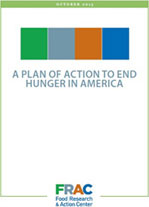Media Contact:
Emily Pickren
epickren@frac.org
202-640-1118
Statement attributed to James D. Weill, president, Food Research & Action Center.
WASHINGTON, April 12, 2018 — The Supplemental Nutrition Assistance Program (SNAP) — the nation’s most critical anti-hunger program — primarily supports working families earning low wages, seniors, children, and people with disabilities. House Agriculture Committee Chairman Michael Conaway’s (R-TX) draft farm bill, released today, seeks to erode the effectiveness of SNAP in ensuring that those who struggle against hunger can afford to put food on the table. The proposals in this bill would lead to greater hunger and poverty among all types of beneficiary families, including the working poor, as well as reduced economic growth and productivity in communities across the country.
- Under this bill, large numbers of working families with children would no longer receive SNAP, there would be a much harsher “cliff effect” in the program, and, in turn, children would be denied access to other essential anti-hunger programs, such as school breakfast and lunch, putting their health and learning at risk.
- Many low-income households, including those that receive SNAP, are often forced to choose between paying heating bills or buying food. The bill slashes the amount of benefits for SNAP households struggling to pay for both utilities and food — to “heat and eat.”
- The bill also seeks to expand dramatically the number of people subject to harsh SNAP eligibility cutoffs by adding unemployed and underemployed parents with older children and adults up to age 60. Currently, time limits apply to able-bodied adults age 18–50 without dependents, many of whom are between jobs or do not have steady enough work to meet the 20-hour per week minimum, often for reasons outside of their control. Others face significant barriers to work, such as lack of job opportunities and lack of transportation to get to the few available jobs.
No amount of reinvestment in an employment and training bureaucracy or other services can make up for this assault on the (already limited) food budgets of hungry people.
These changes to SNAP would affect people in all areas of the country, but low-income people in rural areas would be hardest hit. Households in rural areas and small towns continue to be more likely to receive assistance from SNAP than their metro area counterparts, according to FRAC’s SNAP Maps. On average, from 2012–2016, 15.8 percent of households in rural counties and 15.3 percent of households in small town counties nationwide participated in SNAP, compared to 12.6 percent of households in metro areas across the country.
Congress must recognize that large numbers of their constituents in every part of the country are struggling, and the solution to lifting people out of hunger and poverty is to increase the amount of SNAP benefits for people who need them and support well-paying jobs that provide real opportunity for people to support themselves and their families based on their earnings.
FRAC will continue working with our national, state, and local partners to urge Members of Congress on both sides of the aisle to reject the draconian cuts to SNAP in the draft bill that threaten to needlessly kick millions of people off of an effective, proven program — one that helps struggling individuals and families put food on the table and keeps or lifts millions of people out of poverty each year.
###
The Food Research & Action Center is the leading national nonprofit organization working to eradicate poverty-related hunger and undernutrition in the United States.


